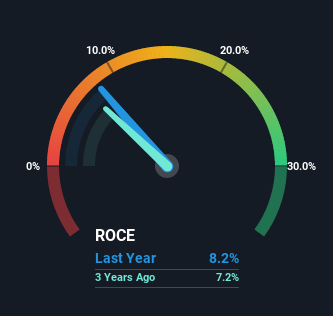- United States
- /
- Semiconductors
- /
- NasdaqGS:FORM
Here's What To Make Of FormFactor's (NASDAQ:FORM) Decelerating Rates Of Return

If we want to find a stock that could multiply over the long term, what are the underlying trends we should look for? One common approach is to try and find a company with returns on capital employed (ROCE) that are increasing, in conjunction with a growing amount of capital employed. This shows us that it's a compounding machine, able to continually reinvest its earnings back into the business and generate higher returns. Having said that, from a first glance at FormFactor (NASDAQ:FORM) we aren't jumping out of our chairs at how returns are trending, but let's have a deeper look.
Return On Capital Employed (ROCE): What Is It?
Just to clarify if you're unsure, ROCE is a metric for evaluating how much pre-tax income (in percentage terms) a company earns on the capital invested in its business. The formula for this calculation on FormFactor is:
Return on Capital Employed = Earnings Before Interest and Tax (EBIT) ÷ (Total Assets - Current Liabilities)
0.082 = US$71m ÷ (US$1.0b - US$150m) (Based on the trailing twelve months to December 2022).
Therefore, FormFactor has an ROCE of 8.2%. Ultimately, that's a low return and it under-performs the Semiconductor industry average of 14%.
See our latest analysis for FormFactor

In the above chart we have measured FormFactor's prior ROCE against its prior performance, but the future is arguably more important. If you'd like to see what analysts are forecasting going forward, you should check out our free report for FormFactor.
What The Trend Of ROCE Can Tell Us
The returns on capital haven't changed much for FormFactor in recent years. The company has employed 55% more capital in the last five years, and the returns on that capital have remained stable at 8.2%. Given the company has increased the amount of capital employed, it appears the investments that have been made simply don't provide a high return on capital.
The Bottom Line
Long story short, while FormFactor has been reinvesting its capital, the returns that it's generating haven't increased. Investors must think there's better things to come because the stock has knocked it out of the park, delivering a 106% gain to shareholders who have held over the last five years. But if the trajectory of these underlying trends continue, we think the likelihood of it being a multi-bagger from here isn't high.
Like most companies, FormFactor does come with some risks, and we've found 3 warning signs that you should be aware of.
For those who like to invest in solid companies, check out this free list of companies with solid balance sheets and high returns on equity.
New: AI Stock Screener & Alerts
Our new AI Stock Screener scans the market every day to uncover opportunities.
• Dividend Powerhouses (3%+ Yield)
• Undervalued Small Caps with Insider Buying
• High growth Tech and AI Companies
Or build your own from over 50 metrics.
Have feedback on this article? Concerned about the content? Get in touch with us directly. Alternatively, email editorial-team (at) simplywallst.com.
This article by Simply Wall St is general in nature. We provide commentary based on historical data and analyst forecasts only using an unbiased methodology and our articles are not intended to be financial advice. It does not constitute a recommendation to buy or sell any stock, and does not take account of your objectives, or your financial situation. We aim to bring you long-term focused analysis driven by fundamental data. Note that our analysis may not factor in the latest price-sensitive company announcements or qualitative material. Simply Wall St has no position in any stocks mentioned.
About NasdaqGS:FORM
FormFactor
Designs, manufactures, and sells probe cards, analytical probes, probe stations, metrology systems, thermal systems, and cryogenic systems to semiconductor companies and scientific institutions.
Flawless balance sheet and slightly overvalued.
Similar Companies
Market Insights
Community Narratives



